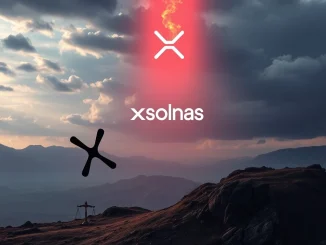
The global financial watchdog, the Financial Stability Board (FSB), has issued a significant FSB crypto warning, indicating that the potential risks posed by the cryptocurrency market to traditional finance are nearing a critical point. This isn’t just about volatile asset prices; it’s about the increasing connections between these two worlds that could transmit shocks.
What is the FSB Crypto Warning All About?
FSB Chair Klaas Knot delivered this stark FSB crypto warning during a speech in Madrid on June 12. The core message is clear: the lines between the crypto ecosystem and the established financial system are blurring rapidly, creating new vulnerabilities.
He highlighted that this growing interlinkage isn’t just theoretical anymore. It’s manifesting in concrete ways that could transmit shocks from the volatile crypto market into the broader financial landscape, potentially leading to crypto systemic risk. The concern is that as more traditional institutions and investors engage with crypto, issues in the crypto market could have ripple effects that impact banks, investment funds, and even sovereign debt markets.
Why Are Crypto ETFs and Stablecoins Raising Systemic Risk Concerns?
Two specific areas were singled out as key drivers of this increased connectivity and potential crypto systemic risk: retail access via investment products like ETFs and the significant role of stablecoins.
- Crypto ETFs Risk: Exchange-Traded Funds (ETFs) provide an easy on-ramp for everyday investors and traditional financial players to gain exposure to crypto assets without directly holding them. While this boosts adoption, it also means that large amounts of traditional capital are now directly linked to crypto price movements through regulated financial instruments. A sharp downturn in crypto could trigger sell-offs in these ETFs, potentially impacting the funds that hold them and the broader market sentiment, contributing to crypto ETFs risk.
- Stablecoins and Systemic Risk: Stablecoins are designed to maintain a stable value, often pegged to a fiat currency like the US dollar. They act as a crucial bridge within the crypto ecosystem and between crypto and traditional finance. However, the reserves backing these stablecoins are a major point of connection and potential risk.
What Does This FSB Warning Mean for Crypto Regulation?
The FSB crypto warning strongly implies that current regulatory frameworks may not be sufficient to manage the evolving risks. As the links deepen, the need for comprehensive and coordinated crypto regulation becomes more urgent.
Regulatory bodies globally are grappling with how to oversee a decentralized and rapidly innovating sector. The FSB’s stance reinforces the view that a wait-and-see approach is becoming less viable as the potential for contagion grows. Future crypto regulation efforts will likely focus on ensuring stablecoin stability, overseeing platforms that offer crypto access (like those facilitating ETFs), and monitoring the exposure of traditional financial institutions to crypto assets. The goal is to build resilience and prevent crypto volatility from destabilizing the wider economy.
How Do Stablecoins Holding US Treasuries Increase Crypto’s Risk?
A critical detail highlighted is the increasing amount of stablecoin US Treasuries holdings. Major stablecoin issuers hold vast reserves, and a significant portion of these reserves are invested in short-term US government debt. This creates a direct and substantial link between the crypto market and the traditional sovereign debt market.
If a major stablecoin were to face a large number of redemption requests (like a bank run), it might be forced to sell off large volumes of its stablecoin US Treasuries holdings quickly. Such forced sales could potentially disrupt the Treasury market, which is a cornerstone of global finance. This mechanism demonstrates how instability originating in the crypto market can be transmitted directly into the heart of the traditional financial system, reinforcing the FSB’s concerns about crypto systemic risk.
Conclusion: The FSB crypto warning from Chair Klaas Knot serves as a stark reminder that the integration of crypto and traditional finance, while bringing innovation and access, also introduces new and complex risks. The growing reliance on instruments like ETFs and the significant holdings of stablecoin US Treasuries mean that the health of the crypto market is becoming increasingly relevant to the stability of the entire financial system. Regulatory bodies are clearly watching closely, emphasizing the urgent need for effective crypto regulation to navigate this evolving landscape and mitigate the potential for crypto systemic risk before it crosses a critical threshold.



